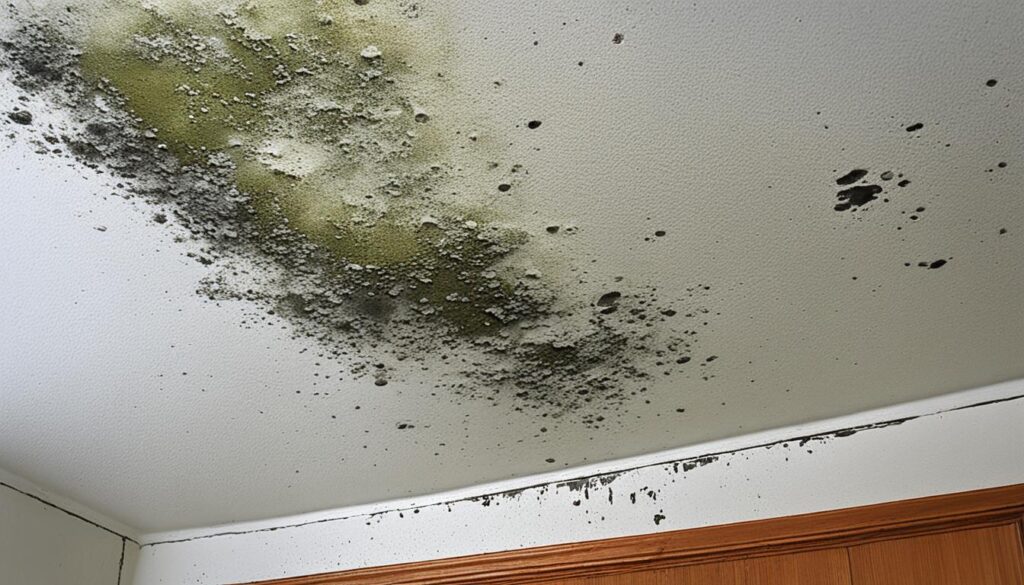
Can Mould Spores Spread Throughout Your Home?
Mould spores can be a silent and invisible threat within your home, capable of spreading from an affected area to other locations. This not only poses risks to your property but also to your health.
In this section, we will explore the ways in which mould spores can spread within your home and discuss important strategies for preventing their widespread contamination. By understanding the transmission mechanisms and addressing the factors contributing to mould spore spread, you can effectively control their movement and maintain a healthy living environment.
Key Takeaways:
- Mould spores can spread from one area to another within your home, leading to widespread contamination.
- Understanding the transmission mechanisms and factors affecting mould spore spread is vital for effective prevention.
- Implementing proactive measures like effective cleaning methods and moisture control can help prevent mould spore spread.
- Seeking professional assistance, such as Fix Mold Miami, can ensure thorough assessments and remediation of mould issues.
- By taking these steps, you can safeguard your home from mould contamination and protect your health.
Understanding Mould Spore Transmission
When it comes to mould spores, understanding how they travel within your home is key to effectively controlling their spread. Mould spores have the ability to move from one location to another, leading to the contamination of various areas. By comprehending the mechanisms of mould spore transmission, you can take proactive steps to prevent their proliferation.
One of the primary ways in which mould spores spread is through air currents. When mould colonies release spores into the air, they can easily be carried to different parts of your house, allowing for the development of new colonies. This is why you may notice mould growth in rooms that are distant from the initial source of contamination.
The transmission of mould spores through air currents creates the potential for rapid and extensive mould growth throughout your home.
Mould spores can also spread through direct contact. Physical disturbance, such as brushing against a mould-contaminated surface or moving objects that have mould growth, can cause the release of spores. These released spores can land on other surfaces, leading to new mould colonies.
Moisture plays a crucial role in mould spore transmission as well. When surfaces become wet, whether from a leaking pipe or high humidity levels, it creates an environment that supports mould growth. Mould spores that are present in the air can land on these wet surfaces and begin to proliferate, spreading the contamination.
It’s important to note that mould spores can also be transported through clothing, shoes, and pets. When these spores hitch a ride on such items, they can be deposited in different areas of the house, causing new mould colonies to form.
In order to effectively control the spread of mould spores, it is essential to address the root causes of mould growth, such as moisture issues and humidity control. By controlling these factors, you can minimize the airborne transmission of mould spores and prevent cross-contamination within your home.
Next, we will explore the various factors that contribute to the spread of mould spores within a house and how to identify and address them effectively.
Factors Affecting Mould Spore Spread
In this section, we will discuss the various factors that can contribute to the spread of mould spores within a house. Identifying and addressing these factors is crucial in preventing the further contamination of different areas.
When it comes to controlling mould spread in a house, understanding the factors that influence mould spore transfer is essential. By targeting these factors, you can effectively minimize the spread of mould spores and protect your home from further contamination.
One of the primary factors contributing to mould spore spread is excess moisture. Moisture accumulation provides an ideal environment for mould growth and enables the release of mould spores into the air. High humidity levels, water damage, plumbing leaks, and condensation are common sources of moisture in homes, creating conditions that facilitate the spread of mould spores.
Another factor that fosters mould spore transfer is inadequate ventilation. Insufficient airflow and poor ventilation can create trapped moisture and increase humidity levels, creating an environment conducive to mould growth and spore release. Areas with limited ventilation, such as basements, bathrooms, and crawl spaces, are particularly vulnerable to mould spore spread.
Furthermore, porous and absorbent materials within a house, such as carpeting, upholstery, and drywall, can harbor mould spores. These materials can act as reservoirs, allowing mould spores to accumulate and spread to other areas. It is crucial to address any mould-contaminated materials promptly to prevent the further dissemination of spores.
Occupant activities can also influence the spread of mould spores. Activities like cleaning, dusting, or moving objects in an area affected by mould can disturb the spores and disperse them into the air, potentially contaminating other areas. Proper containment and precautions should be taken when dealing with mould-infected areas to minimize the transfer of spores.
To control mould spread and prevent cross-contamination, it is important to address these factors. By reducing moisture levels and improving ventilation, you can create an environment that is less conducive to mould growth and spore release. Additionally, regular cleaning, use of air filters, and proper maintenance of affected materials can help minimize the spread of mould spores.
Next, we will explore the common routes through which mould spores can be transferred within a house. Understanding these routes will provide crucial insights for implementing effective prevention strategies. But first, let’s take a look at a relevant quote:
“Preventing the spread of mould spores starts with identifying the factors that contribute to their transfer. By addressing moisture, ventilation, and contaminated materials, you can significantly reduce the risk of mould spores spreading throughout your home.”

Factor Checklist for Controlling Mould Spore Spread:
- Address excess moisture and water damage
- Improve ventilation and airflow
- Remove and replace mould-contaminated materials
- Take precautions during cleaning and disturbance of mould-infected areas
- Regularly clean and maintain affected surfaces
- Use air filters to minimize airborne mould spores
Understanding these factors and implementing the necessary measures will help you control the spread of mould spores within your home. In the next section, we will explore the common routes through which mould spores can be transferred, providing valuable insights for effective prevention strategies.
Common Routes of Mould Spore Transfer
Understanding the common routes through which mould spores can travel within a house is essential in preventing their spread and minimizing cross-contamination. By being aware of these routes, you can take proactive measures to create a healthier living environment and prevent the negative effects of mould contamination.
1. Airborne Transfer
Mould spores can easily become airborne and travel to different areas of your home through air currents. Whenever you open doors or windows, use ventilation systems, or even walk through a room, you may unknowingly propel spores into the air. Once airborne, these microscopic particles can settle on surfaces or be inhaled by occupants, leading to the potential spread of mould contamination.
2. HVAC Systems
Heating, ventilation, and air conditioning (HVAC) systems can be a significant pathway for mould spores to spread throughout your home. As the air circulates through the ducts, it carries any mould spores present, dispersing them to various rooms. Regular maintenance and cleaning of your HVAC system are crucial in preventing the transfer of mould spores.
3. Clothing and Pets
Mould spores can hitch a ride on clothing, shoes, and even the fur of pets, enabling them to be transported from one area to another. It’s essential to be mindful of this when moving between contaminated and uncontaminated areas. Taking appropriate precautions, such as removing and washing contaminated clothing, wiping down pets, and cleaning their bedding, can help prevent the spread of mould spores.
4. Personal Belongings
Your personal belongings, such as books, papers, and furniture, can also serve as vehicles for mould spore transfer. Spores may settle on these items and be transported to different parts of your home, leading to the potential contamination of previously unaffected areas. Regular cleaning and inspection of your belongings can help prevent the spread of mould spores.
5. Water and Moisture
Water and moisture are primary factors in mould growth and spore release. Spores can be present in moist areas such as bathrooms, kitchens, and basements, and they can spread to adjacent rooms or areas along with the moisture. To prevent mould spore transfer, it’s crucial to address water leaks, control humidity levels, and promptly dry any wet areas in your home.
By understanding these common routes of mould spore transfer, you can take proactive measures to minimize their spread and prevent cross-contamination. Implementing effective cleaning, maintenance, and prevention strategies will help create a healthier living environment free from the negative effects of mould contamination.
Controlling Mould Spread in Your Home
Mould contamination in your home can lead to various health issues and damage to your property. It is crucial to take proactive steps to control the spread of mould spores and maintain a healthy living environment. In this section, we will explore practical strategies that you can implement to effectively control mould spread in your home.
1. Effective Cleaning Methods
Regular cleaning is essential to prevent the accumulation and spread of mould spores. Use appropriate cleaning products and techniques to thoroughly clean areas prone to mould growth, such as bathrooms, kitchens, and basements. Pay special attention to areas with high moisture levels, as mould thrives in damp environments.
2. Reduce Moisture Levels
Mould requires moisture to grow and spread. Take steps to reduce moisture levels in your home by ensuring proper ventilation, using dehumidifiers, and fixing any plumbing or water leak issues promptly. Keep humidity levels below 50% to create an inhospitable environment for mould growth.
3. Repair Water Damage
If your home has experienced water damage, it is important to address the issue promptly to prevent mould contamination. Repair any leaks, fix damaged roofs or windows, and dry out wet areas thoroughly. By addressing water damage, you can eliminate the conditions that promote mould growth.
4. Properly Ventilate Your Home
Adequate ventilation is crucial in controlling mould spread. Properly ventilate areas prone to moisture, such as bathrooms and kitchens, by using exhaust fans or opening windows. Improved airflow helps reduce humidity and prevents the buildup of moisture, minimizing the chances of mould growth.
5. Use Mould-Resistant Materials
When renovating or building your home, consider using mould-resistant materials in areas prone to moisture, such as bathrooms and basements. These materials, such as mould-resistant drywall or paint, are designed to inhibit mould growth, reducing the risk of contamination.
6. Monitor Humidity Levels
Regularly monitor the humidity levels in your home using a hygrometer. This device measures indoor humidity and helps you identify areas with high moisture levels. By keeping track of humidity, you can take necessary actions to maintain optimal levels and prevent mould growth.

Implementing these strategies can go a long way in controlling the spread of mould in your home. By being proactive and taking preventive measures, you can create a healthier living environment for you and your family.
Seeking Professional Assistance
If you suspect extensive mold contamination or need expert assistance in assessing and remedying the issue, it’s essential to reach out to professionals who specialize in mold assessments, prevention, and remediation. One such trusted service provider is Fix Mold Miami.
Fix Mold Miami is Florida’s top-rated expert when it comes to dealing with mold-related problems. With their years of experience and proven track record, they have earned a reputation for providing effective solutions tailored to each client’s specific needs.
When you enlist the assistance of Fix Mold Miami, you can be confident that your mold issues will be addressed comprehensively and professionally. Their team of skilled technicians utilizes cutting-edge techniques and equipment to ensure accurate mold assessment, efficient prevention, and thorough remediation.
Whether you are dealing with mold spore transfer within your house, extensive mold contamination, or simply need guidance on how to prevent mold growth, Fix Mold Miami has got you covered. They understand the importance of a mold-free environment for your health and well-being.
By seeking professional assistance from Fix Mold Miami, you can have peace of mind knowing that their experts will work tirelessly to identify the root causes of mold growth, implement effective strategies to prevent further spread, and restore your home to a safe and healthy condition.
Conclusion
Throughout this article, we have examined the spread of mould spores within your home and the importance of implementing effective prevention strategies. By understanding how mould spores can be transmitted from one area to another, you can take proactive measures to control their spread and maintain a healthy living environment.
Controlling mould spread in a house starts with identifying the factors that contribute to its transmission. Whether it’s through air circulation, moisture transfer, or human activity, addressing these factors is crucial in preventing cross-contamination and reducing the risk of house mould spores transmission.
Furthermore, implementing practical strategies such as regular cleaning, maintaining optimal humidity levels, and addressing any water leaks or moisture issues can significantly reduce the presence of mould spores in your home. By following these preventive measures, you can create a living space that is less susceptible to mould growth and its potential health risks.
In situations where extensive mould contamination is suspected, seeking professional assistance is highly recommended. Companies like Fix Mold Miami, Florida’s leading experts in mould assessments, prevention, and remediation, can provide the expertise and services needed to assess the extent of the issue and effectively carry out necessary remediation efforts.




